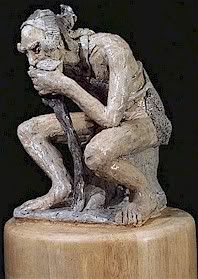Evil

I happened to notice a student recently who was wearing a headband that was stitched with all sort of icons, one being the old flag of the Soviet Union. She was maybe all of 16, just born when the Berlin Wall came crashing down in 1989, and she never lived with the fear that the Cold War brought with it. Today we can view old movies about civil defense and silly cartoons like "Duck and Cover" (if you haven't seen this sort of thing, I recommend going to Cold War and scroll down a little bit and you'll see a hyperlink to take you to a "Bert the Turtle" duck and cover cartoon you can watch), and wonder how it could have been like that at one time. She also hadn't lived through the civil defense drills of the fifties where you practiced ducking and covering while you were in school:

Crap like this was spewed out by the U.S. government to convince people that living after nuclear attack was indeed possible, and it was true, you could live after such an attack, but those cartoons and such didn't address what the quality of your life was apt to be afterwards.
There was one thing that was clear, we were good and they were bad; and that was, on the whole, pretty much true. I'm not saying that we were always did what was right, or that we
didn't do a lot that was wrong, or do things that were more in the context of our own interest as a nation vice humanities, but on the whole we represented values and freedoms that simply didn't exist in the communist block, and no matter how amoral our foreign policy was we never treated our own citizens the way the Soviet and Chinese communists, especially during the time of Stalin and Mao, treated theirs. I remember thinking to myself when that girl passed if she knew that the icon she wore, in amongst all the others, represented one of the worst evils ever to stamp itself on this planet, that in fact the flag represented an evil almost, though not
quite, as heinous as the does the swastika.
I'm finishing Jonathan Glover's "Humanity: A Moral History of the Twentieth Century":

Glover's book has brought to mind that girl and what she doesn't know, and rekindled things that I knew that I hadn't much thought of for the past ten or so years. When I first joined the Navy back in 1981 the only real enemy we had was the Soviet Union. We trained with its ships in mind, we pondered what it would be like meeting its fleet at sea, and we were very conscious that if the world was going to come to an end, and back then that thought was very real for most of us who'd lived through the Cuban Missile Crisis, it was going to be because of a conflagration between us and the Russians. Part of my "indoctrination", as it were, was about the Russians being the enemy we were most apt to fight, but it was never what I'd call a brainwashing --- it was somehow just accepted, they were the ones thwarting the good, they represented the oppressed and, fundamentally, evil. Much of what I read independent of the Navy convinced me of this and there was no question of my believing it, as I do still. Glover reminds me of why my thinking was so true.
Glover reminds us with the following about Russia under Stalin (pages 237 - 238 in Humanity):
"Numbers are disputed. One estimate is that, in the seventy years after 1917, the Soviet regime killed 61,911,000 people. Another estimate puts the deaths for 1937 - 8 at over a million executed and a further 2 million who died in the camps, these figures being part of an overall 20 million who were killed in the whole Stalinist period. Another estimate (ascribed to a KGB report to Khrushchev) is that 7 million people were killed in six and a half years between January 1935 and June 1941. Yet another estimate is that 9.5 million people were killed in the decades of the 1930's.
"These estimates cover wider and narrower periods and use different methods of assessment. Here it is not necessary to try to decide between them. A very rough idea is enough. Stalinist deliberate killing was on a scale surpassed only by war.
"Many were executed, often in mass executions. Some died in compulsory movement of population, which in effect were often mass murder. Others died in deliberately created famine, or working on huge slave-labor construction projects, or as the result of their treatment in the camps."
Mao wasn't far behind, with between 20 to 30 million dying in the period of 1958 to 1962 during the Great Leap Forward. Mao created a totalitarian culture that literally brainwashed the people, over 1/2 a billion of them, into a "right way of thinking" that was dictated very much by him. How Mao and Stalin came about doing what they did had its differences, but it all flowed from their ideological belief and interpretation of communist philosophy.

0 Comments:
Post a Comment
<< Home